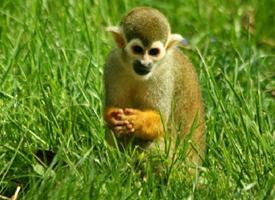
Weights and measures
| Length | from 26 to 30 cm |
|---|---|
| Weight | from 0,6 to 1,4 kg |
| Tail lenght | from 35 to 42 cm |
Biological data
| Length of gestation | from 168 to 182 d |
|---|---|
| Number of young | 1 |
Animal description
The Guianan squirrel monkey, scientifically known as Saimiri sciureus, is a small and vivacious primate native to the tropical forests of South America. This species is particularly prevalent in the Guiana Shield, an ecologically rich area that encompasses parts of Brazil, Venezuela, Guyana, Suriname, and French Guiana. Characterized by their agility and sociability, Guianan squirrel monkeys play a fascinating role in the biodiversity of their habitats.Physically, the Guianan squirrel monkey is a sight to behold, with distinctive features that set it apart from other primate species. Adults typically weigh between 750 grams to 1.1 kilograms, with males usually being slightly larger than females. They possess a slender build and a tail that is longer than their body, which aids in balance but is not prehensile. Their fur is primarily olive or grey in color, with a brighter, yellowish hue on their legs and a white face that contrasts sharply with a black muzzle. This facial pattern is thought to reduce glare from the sun and improve their vision in the bright, tropical light.
One of the most striking aspects of the Guianan squirrel monkey's appearance is its expressive eyes, which are surrounded by white fur, giving the impression of wearing a mask. This, along with their small size and dexterous movements, contributes to their "squirrel-like" appearance and name. Their hands and feet are agile, equipped for a life spent mostly in the trees. They have nails instead of claws on all fingers and toes except for the big toe, which retains a claw for grooming purposes.
Behaviorally, Guianan squirrel monkeys are highly social creatures, forming large troops that can number over 100 individuals. These groups are matriarchal, with females generally occupying higher ranks within the social hierarchy than males. They communicate through a variety of vocalizations, facial expressions, and body postures, which serve to coordinate movements, establish social bonds, and signal warnings of predators.
Their diet is omnivorous but primarily consists of fruits and insects. The monkeys are known to play a crucial role in their ecosystem as seed dispersers, aiding in the regeneration of their forest habitats. They have a remarkable ability to remember the locations of fruiting trees and the timing of fruit availability, showcasing their adaptability and intelligence.
Despite their adaptability, Guianan squirrel monkeys face threats from habitat destruction due to deforestation and the illegal pet trade. Their habitats are increasingly being fragmented by human activity, which poses challenges to their survival. Conservation efforts are underway in several regions to protect these monkeys and their habitats, including establishing protected areas and enforcing laws against illegal trading.
In summary, the Guianan squirrel monkey is a captivating species, embodying the vibrancy and complexity of South American tropical forests. Their social nature, distinctive appearance, and ecological role make them an integral part of the biodiversity in their habitat. As with many wildlife species, understanding and protecting them is crucial for maintaining the health and diversity of our planet's ecosystems.
Similar Animals
New photos of animals
Top 10 animals
- Dolphin gull (Leucophaeus scoresbii)
- Diana monkey (Cercopithecus diana)
- Moustached guenon (Cercopithecus cephus)
- Galápagos tortoise (Geochelone nigra complex)
- Japanese macaque (Macaca fuscata)
- Stone loach (Barbatula barbatula)
- Russian tortoise (Testudo horsfieldii)
- Greek tortoise (Testudo graeca)
- Common flying dragon (Draco volans)
- Vendace (Coregonus albula)
